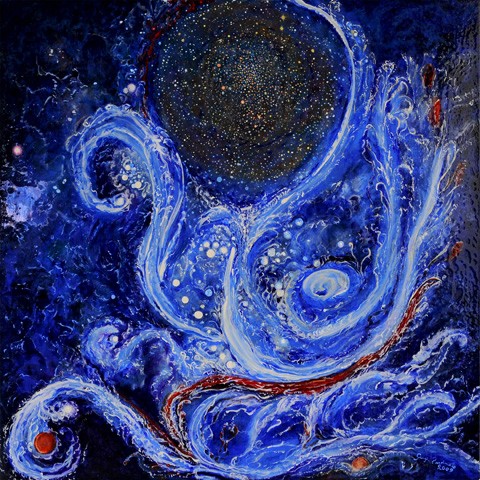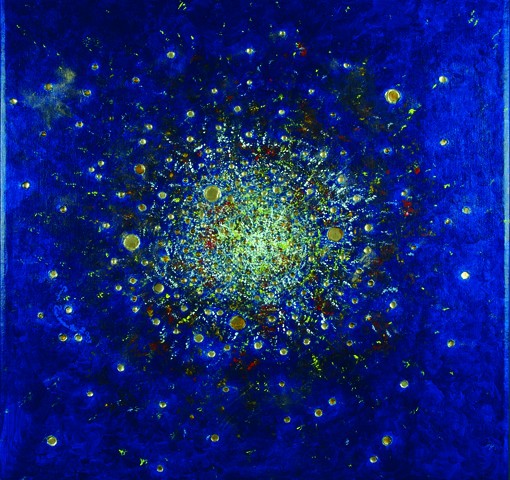Studio Tablinum: eclecticism does not seem to be a distinctive tendency nowadays, so far from that era when an artist was also a scientist, with a breadth of knowledge in both fields. However, Giorgio Tardonato’s marvellous works give us the impression to be before someone who deeply knows science, and astronomy in particular. His paintings abound with starts, comets, cosmic clouds as well as fantastic antimatter galaxies, cosmic crystals and negative skies…a truly “impressionist” vision of Space.

Giorgio, first of all I would like to talk about your activity as an amateur astronomer. Over the last few years, you have contributed to divulgate astronomy from both a cultural and practical point of view, offering your collaboration to a series of public initiatives. How do you combine this passion with art? Do you see art as a way to divulgate astronomy?
Man is the only animal who can look at the sky. Others can do it through an unnatural effort, whereas for mankind is almost spontaneous. Astronomic observation has guided the history of human society, and now that we can really know the depths of the universe, few people seem to be interested in the sky. We rediscovered the ancient amazement as soon as we are far away from artificial lights. I noticed it during all the initiatives of sky observations organised for the public, even when there were not any instruments, and all we had was the name and picture of the stars. Beauty and amazement mark astronomy divulgation, even in its more simple terms. Art nourishes itself with the same things: beauty and amazement. I simply combined two passions, cultivated since my early age.
I still keep abreast of science, experimenting painting techniques blended with scientific hypothesis in order to represent old and newly discovered objects, picturing how they could be.
Your painting has been defined as “astronomical” or belonging to Space Art, a style that the American artist Chesley Bonestell (1888-1986) first developed with a series of realistic scenarios for future spatial explorations, often carried out by NASA, with an extremely figurative slant. Meanwhile in Europe, the same style was tending towards a stylization of abstract shapes, following the example of Futurism. Did you have a specific source of inspiration for your works in this sense?
Bonestell for sure, firstly known when I was a child and my mother was helping me collect Liebig sticker. This was the series I liked the most. The encounter with dear Ms Adriana also played a fundamental role: she was the painter who has taught me how to paint for 12 years. Both Italian and French, she had studied at the Academy of Fine Arts in Paris and had an impressionist mark. At the end of my course, she suggested that I should have specialised, carefully choosing what and how to paint afterwards.
The first astronomical painting was made together, painting the hydrogen clouds of Orion Nebula in a similar way to those of an impressionist landscape.
In your works you experiment a great variety of materials and techniques: from oil paintings or acrylic on canvas to dipthyc and triptych, as well as statues in transparent resin and photography: every time you manage to represent, with scientific rigour, wonder and astonishment for the Universe. How much time does it take to find the right way to represent such a distant world, to which we however belong?
At the root of each painting there is the knowledge of the subject. Each painting is unique, I never repeat myself. Technical difficulties are due to the fact that celestial bodies are bright, without embracing the contrast of lights and shades which is the base of normal paintings. I must represent a source of brightness and shape its depth: I work out this problem in a different way every time. I study books and magazines and I surf on the Internet; for every subject I never use only one image, but I combine different images with the sensation of being on a spacecraft, close enough to feel their own depth. Finding the motivation to realise what I have in my mind can be very hard, and it requires the same amount of time than experimenting different techniques and materials, in order to reach positive outcomes. At times, I am surprised myself by the final aspect of the work. It is true that reality overcomes fantasy.
Tell us about your experience at new Florence Biennale 2013 where you participated with our studio.
In Florence, I was pleasantly struck by the high quality of the exhibited works. Contemporary art is often an exhibition in negative. In Milan, Rome, Venice, Rovereto (MART), Paris, Stockholm, Amsterdam, Berlin, London I saw denouncing works, even strange and original, complex and difficult, which never represented the idea of beauty and positivity that Art should convey. On the contrary, Florence Biennale 2013 astonished every artist who I could talk to: we enjoyed each other’s company and we felt absorbed in that kind of futuristic atmosphere with the same harmony that pervades Florence and makes it unique in the world.
I often wondered why in Italy we keep organising retrospective exhibitions, looking at the past as well renowned works, rather than investing in the future and in everything that can enrich our patrimony. This Biennale has provided a good answer. The professional assistance of Studio Tablinum was a discerning factor between do-it-yourself and professionalism. Despite the little space dedicated to my paintings, Alessandro’s work generated such visibility that important Galleries were interested in my paintings. I am also thankful to my graphic designer (studio Sintesi) for the effective leaflets.
You also have a double experience with photography: on the one hand you work for advertisements and documentaries, including videos for both state and private companies, on the other hand you are responsible for artistic production. Has your love for photography influenced the way you see things and thus your analytical way of reproducing Space?
Professional photography requires the same skills of a painter, technique and carefulness. I was able to observe images through the telescope and elaborate my own canvas, transforming them into digital artworks. Experience and technical equipment (purchased thanks to a couple of advertisements for a few clients) gave me the chance to develop, balance the equipment costs as well as acquire IT skills, which are also necessary for astronomy. These two things are complementary and I devote myself to both: sometimes art, at other times photography. Every change implies new solutions.
Together with several groups of amateur astronomers, you contributed to the foundation of the national association Cielo Buio, promoting the protection of nocturnal sky – part of Human Heritage – as well as other landscapes and cultural assets around the world. You therefore combine the artistic activity with the conservation of existing assets, enhancing your “eclectic” nature. In modern artistic contexts, is the lack of conservation or that of creativity that causes more risks?
I organised several conferences, even for state bodies, regarding ecological solutions to night lighting, both to save energy and see stars again. This is a long cultural evolution. As long as nocturnal sky is not important for a vast majority of people, laws will not be able to protect it. The light that we need to walk at night should not darken the stars nor blind our eyes. The starry sky has been declared Human Heritage, but I would rather say that Earth itself should be considered heritage of the starry sky.
Those men who do not look at the sky are forgetting that they have no power, neither to create nor to destroy. They can only choose if they want to indulge nature or if they prefer to find easy and direct solutions, following their own wishes and harming themselves.
Modern Art, in the past as well as in the future, has the aim of representing a problem, an idea, a myth or a hope. The artist shows the right way on behalf of everyone else, sometimes before than everyone else.
If people accept art proposals, art gets successful. However, people often understand art message afterwards and only those representations confirming the existing world are successful.
It is not the artist the one who is risking, but spectators to artists’ works are those that can choose to accept or refuse novelties.
Giorgio Tardonato was born in Erba (Como), Italy, in 1951.
After earning a degree in Modern Literature, worked as a teacher, photographer, artist and popularizer of astronomy.
Lives and works in Eupilio (Co), Italy.


Thank you, I’ve just been looking for information about
this subject for a while and yours is the best I have discovered till now.
But, what about the bottom line? Are you sure in regards to the
supply?
Thank you, i’m glad you”ve found the information you need. What you mean for “supply”? Are you talking about the last question of the interview?
Thank you, i’m glad you”ve found the information you need. What you mean for “supply”? Are you talking about the last question of the interview?
Thank you, I’m glad you’ve found what you need. What you mean for “supply”? Are you talking about the last question of the interview?
Thank you, I’m glad you’ve found what you need. What you mean for “supply”? Are you talking about the last question of the interview?